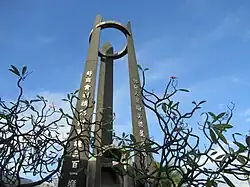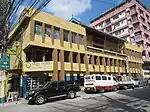| Ruby Tower | |
|---|---|
 | |
| General information | |
| Type | Commercial/residential |
| Location | Doroteo Jose and Teodora Alonso Streets, Santa Cruz, Manila, Philippines |
| Coordinates | 14°36′20″N 120°58′47″E / 14.60556°N 120.97972°E |
| Completed | 1965–1967 |
| Destroyed | August 2, 1968 |
| Height | 20.5 m (67 ft) |
| Dimensions | |
| Other dimensions | 45.5 m × 30 m (149 ft × 98 ft) |
| Technical details | |
| Floor count | 6 |
| Known for | Collapse in 1968 Casiguran earthquake |
The Ruby Tower was a six-story building in Manila, Philippines, completed c. 1965[lower-alpha 1] that collapsed on August 2, 1968, during the Casiguran earthquake killing over 250 people.
Background
The building, constructed at a cost of $250,000,[1] was located on the corner of Doroteo Jose and Teodora Alonso Streets in Santa Cruz, a district in the northern part of Manila.[3] The reinforced-concrete building measured 45.5 m × 30 m (149 ft × 98 ft), with a height of 20.5 m (67 ft). It was of a slab-and-beam design supported by columns, the rear wall with the primary resistance to shear or torsional forces.[4] The mixed commercial and residential building contained 38 commercial spaces on the lower two floors and 76 residential units on the upper four floors.[5] It housed 600 to 1,000 people.[2]
Collapse and rescue effort
The 7.3-magnitude 1968 Casiguran earthquake, centered more than 200 km (120 mi) away,[4] hit at 4:19 am[5] and caused the building to collapse in a pancake fashion burying over 500 people. A volunteer force of over 6,000 mobilized to free the victims trapped in the rubble, as there was no government disaster plan in place at the time. Many people were rescued alive, including about 30 who later died from their injuries.[3] At least 260 people were injured.[5][lower-alpha 2] The rescue effort turned to recovery and lasted over a week. Not all of the bodies were identified.[3]
A part of the northern end of the floors one and two remained standing. The lower levels collapsed straight downward, while the upper floors shifted south as they collapsed, with the roof shifting 30 feet (9.1 m) south and 10 feet (3.0 m) east of its original location.[5] Its long columns buckled in the earthquake.
By August 4, Philippine soldiers and heavy construction equipment were in use.[6] They were assisted for 10 days by personnel of the United States military.[1] In 80% of the building, the collapsed floors were separated by debris (portions of columns and walls) leaving spaces of 3 feet (0.91 m) or less, with very limited lateral movement.[1] As a result, many holes had to be cut through the concrete with jackhammers and oxygen-acetylene torches to reach the pockets.[1] Philippine and US military, and civilian contractors all participated in this work.[1]
Around 3,000 rescuers, including soldiers and civilians, worked daily, all coordinated by Brigadier General Gaudencio Tobias of the Philippine Army.[1] The nearby Cayetano Arellano High School (formerly Manila North High School) was used as a command center, canteen and rest area, medical clinic and morgue.[1] The US effort was directed by Rear Admiral Draper Kauffman and included US Navy and US Marine Corps personnel from Subic Bay Naval Complex and US Army and US Air Force personnel from Clark Air Force Base.[1]
The Philippine Boys Scouts managed the collection and identification of items of value as they were retrieved.[1] The last of the 268 survivors pulled from the building were two girls, aged 9 and 12, who were found on August 9, having survived in the wreckage for 125 hours. Another 260 bodies were retrieved.[1][lower-alpha 3]
The deaths in the collapse accounted for the majority of all deaths in the earthquake,[8] causing the Casiguran earthquake to be alternatively called the Ruby Tower earthquake.[9]
Analysis and legacy
The collapse was attributed to the design, poor workmanship and concrete quality.[4] Court cases were brought alleging both civil and criminal liability.[4] A case against the construction company was brought before the Supreme Court, where the company was found liable for poor construction including insufficient reinforcement in columns, and joints not built to specifications.[10]
After the collapse of Ruby Tower, the Philippines created the National Committee on Disaster Operation (NCDO), predecessor of the National Disaster Risk Reduction and Management Council (NDRRMC), setting minimum standards for building construction. The first national building code was established in 1972 by the Republic Act 6541, An Act to Ordain and Institute a National Building Code of the Philippines. Five years later, it became the National Building Code of the Philippines by order of then President Ferdinand Marcos Sr.[11][lower-alpha 4]

Memorial
The Ruby Tower Memorial Hall is a two-story structure on the site, made from the portion of the building that remained standing, where the victims are remembered. Built in 1974, the shrine includes 100 black and white photographs of people killed in the collapse.[3]
See also
- Ruby Tower Memorial, a memorial in Manila Chinese Cemetery
Notes
References
- 1 2 3 4 5 6 7 8 9 10 11 Whitman, Ens G. J. (November 1968). "Rumy Tower Disaster". Navy Civil Engineer. Washington, D.C.: The United States Navy Civil Engineer Corps and the Facilities Engineering Command. IX (11): 24–25. Retrieved November 6, 2021.
- 1 2 "Quake jams hospitals in Philippines". United Press International. August 2, 1968. Retrieved November 6, 2021.
- 1 2 3 4 Moya, George P. (July 2, 2014). "When an earthquake hits Metro Manila". Rappler.com. Retrieved November 6, 2021.
- 1 2 3 4 5 6 Flores, A. R., The Luzon Earthquakes of August 2, 1968 and April 7, 1970 (PDF), United Nations Education, Scientific, and Cultural Organization
- 1 2 3 4 "Casiguran earthquake". phivolcs.dost.gov.ph. Philippine Institute of Volcanology and Seismology. Retrieved November 6, 2021.
- ↑ "Magnitude 7.6 Strong Earthquake Hits Philippines". gettyimages. Retrieved November 6, 2021.
- ↑ Luci-Atienza, Charissa; Cahiles-Magkilat, Bernie (April 28, 2019). "The Ruby Tower". Manila Bulletin. Retrieved November 6, 2021.
- ↑ Martin, M G (August 1, 2018). "'Big one' quake warning marks 50 years since Manila tower tragedy". philippineslifestyle.com. Philippines Lifestyle News. Retrieved November 6, 2021.
- ↑ Delacruz, Manzel. "Living in Eqrthquake Country". positivelyphilipino.com. Retrieved November 6, 2021.
- ↑ "Aftershocks". pwc.com. PWC Philippines. Retrieved November 6, 2021.
- ↑ "Today in Philippine history, August 2, 1968, a 7.3 earthquake hit Casiguran, collapsed buildings in Manila". kahimyang.com. July 31, 2017. Retrieved November 6, 2021.
- ↑ "Part 2: What makes buildings earthquake-ready?". aseponline.org. Association of Structural Engineers of the Philippines. Retrieved November 6, 2021.
 Media related to Ruby Tower at Wikimedia Commons
Media related to Ruby Tower at Wikimedia Commons